Learn how to make real buttermilk from scratch with this simple method. I’m talking true cultured buttermilk, not the buttermilk substitute you make with vinegar or lemon juice. This is the real deal and is the best to use in baking as it results in much lighter and fluffier baked goods like these flaky homemade buttermilk biscuits!
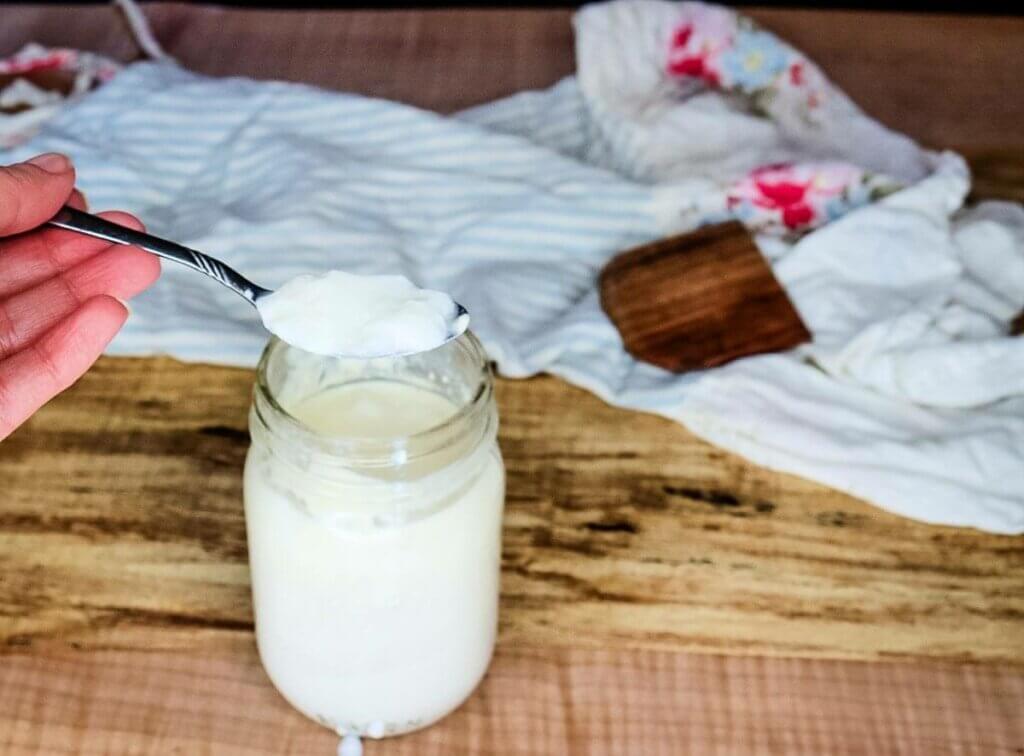
So why should you learn how to make old-fashioned cultured buttermilk when we all know that you can use the hack of taking regular milk, plus an acidic medium like apple cider vinegar or lemon juice to make a suitable buttermilk substitute?
That’s a great question, and the reasons are as follows…
Why Make Cultured Buttermilk NOT a Buttermilk Substitute?
- It’s so easy! As in, pour, stir, then let it do its thing!
- You can take your cultured buttermilk and make more homemade items like homemade cheeses (saving you money on cheese starts).
- Cultured buttermilk helps preserve your milk so it will last longer.
- Cultured buttermilk is considered a fermented food and can help improve your gut health.
- Real cultured buttermilk improves the texture of your baked goods that call for buttermilk (if you’re a skeptic, check out my homemade flaky buttermilk biscuits using REAL buttermilk and you’ll understand why!)
Why Use Buttermilk in Recipes?
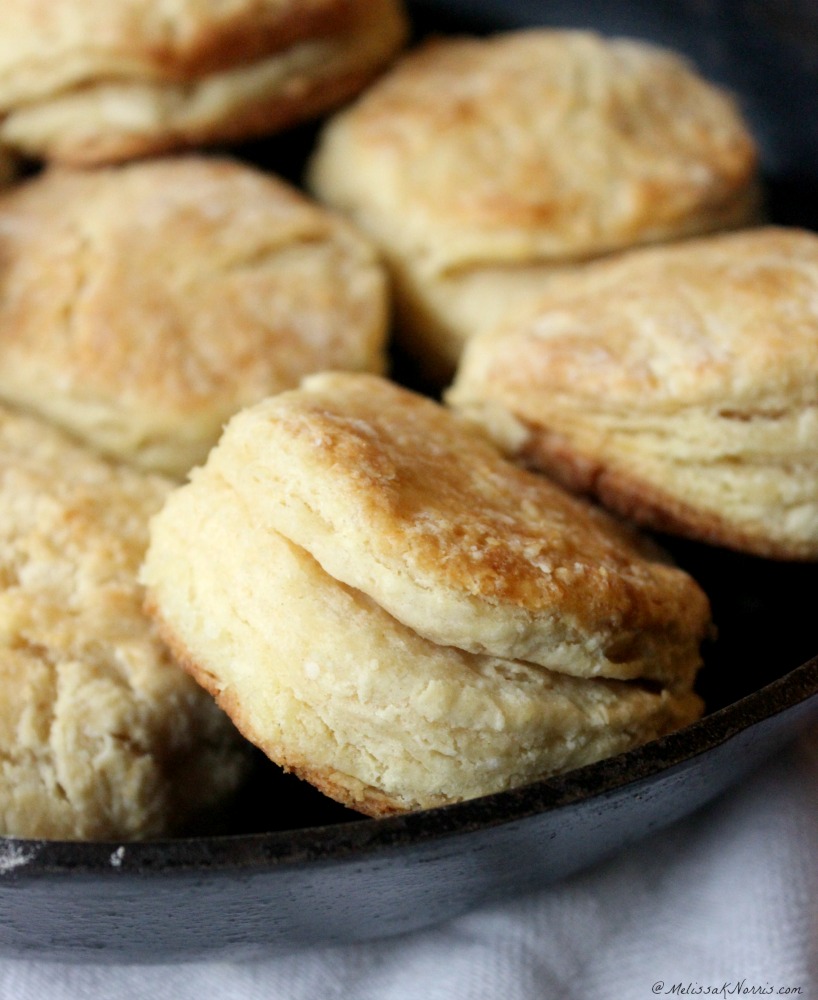
Buttermilk is acidic, meaning it helps activate leavening agents giving your baked goods a light and fluffy, almost airy texture. Do you see all those flaky layers in those biscuits and the golden-brown tops? Buttermilk!
Buttermilk actually helps extend the shelf-life of your baked goods because it contains natural emulsifiers. It also gives your baked goods a beautiful golden-brown color.
Buttermilk can actually be used in baking recipes that don’t call for it specifically, but those that call for yogurt or sour cream.
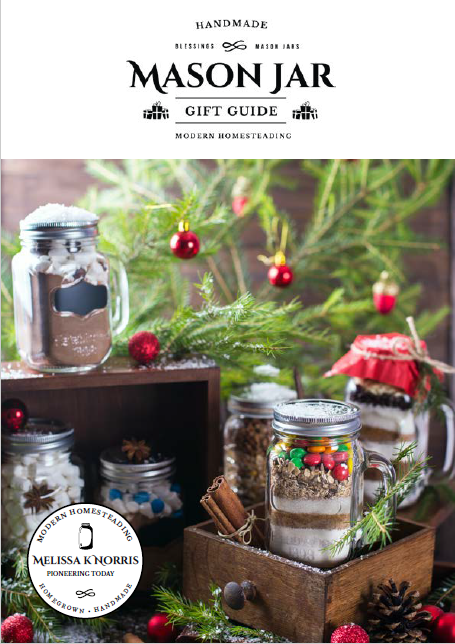
available now
Give the Gift of Homemade—All Year Long
Want to make stunning, heartfelt gifts in less time—with less stress? Get my Mason Jar Gift Guide absolutely free! Inside, you’ll discover step-by-step recipes, printable labels, and creative DIY inspiration—so you can whip up beautiful, delicious, homegrown gifts for every occasion. Perfect for anyone craving a simpler, more meaningful holiday season (or just more joy in your kitchen).
Subscribe to Melissa K. Norris!
Get updates on the latest posts and more from Melissa K. Norris straight to your inbox.
We use your personal data for interest-based advertising, as outlined in our Privacy Notice.
Ingredients
You just need two simple ingredients to make your own homemade buttermilk:
- Milk – you can use store bought whole milk, skim milk, or anything in between for this recipe. Personally, I prefer fresh whole milk from our dairy cow because it makes it extra creamy and thick!
- Buttermilk – yes, it seems odd that you need buttermilk to make buttermilk, but you have to have a culture to inoculate your first batch. Once you have buttermilk going, you can use your existing buttermilk to keep on making it for batches on end. When buying buttermilk from the store, just be sure the container says “live cultures” or else this recipe won’t work. Alternatively, you can use dehydrated buttermilk cultures.
How to Make Real Buttermilk
Remember, we’re not talking buttermilk substitutes here, although the method is similar, this is the real deal, true cultured buttermilk made from milk and live cultures.
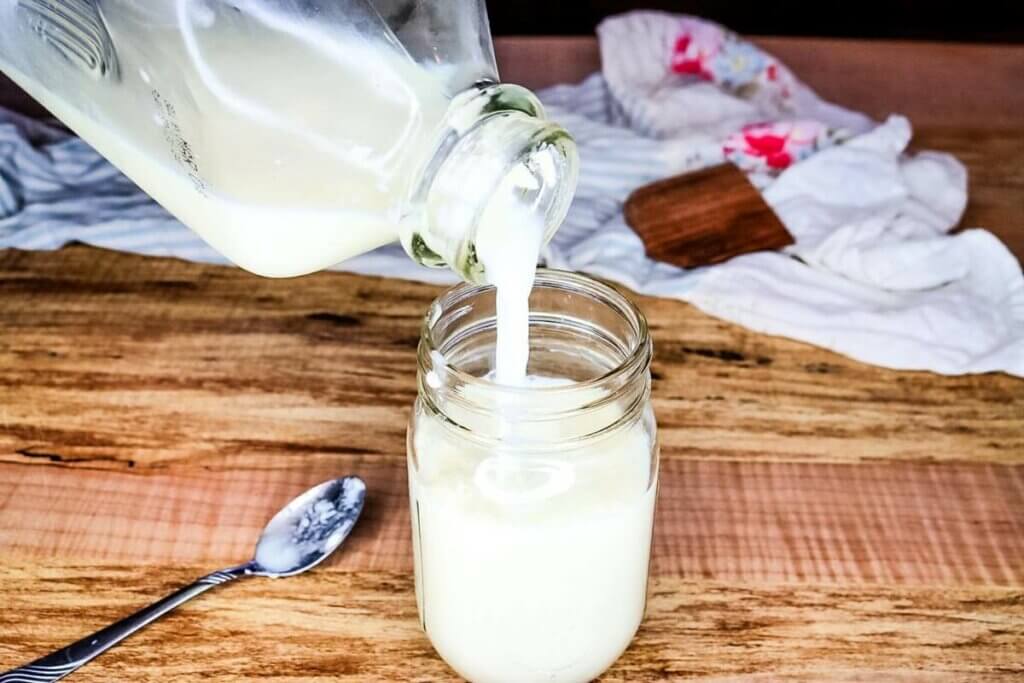
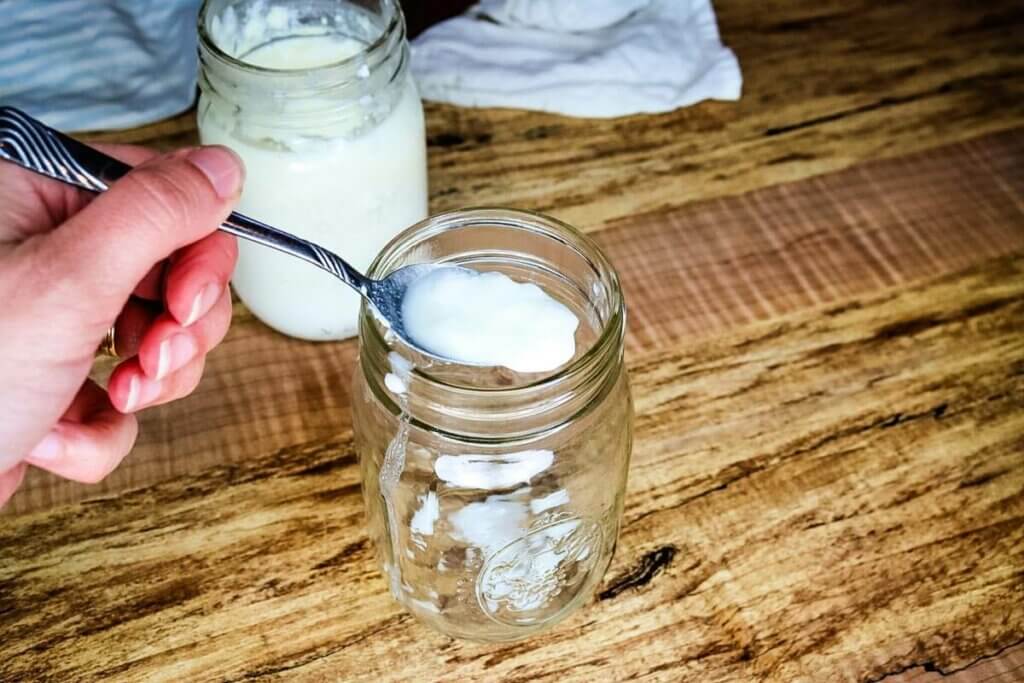
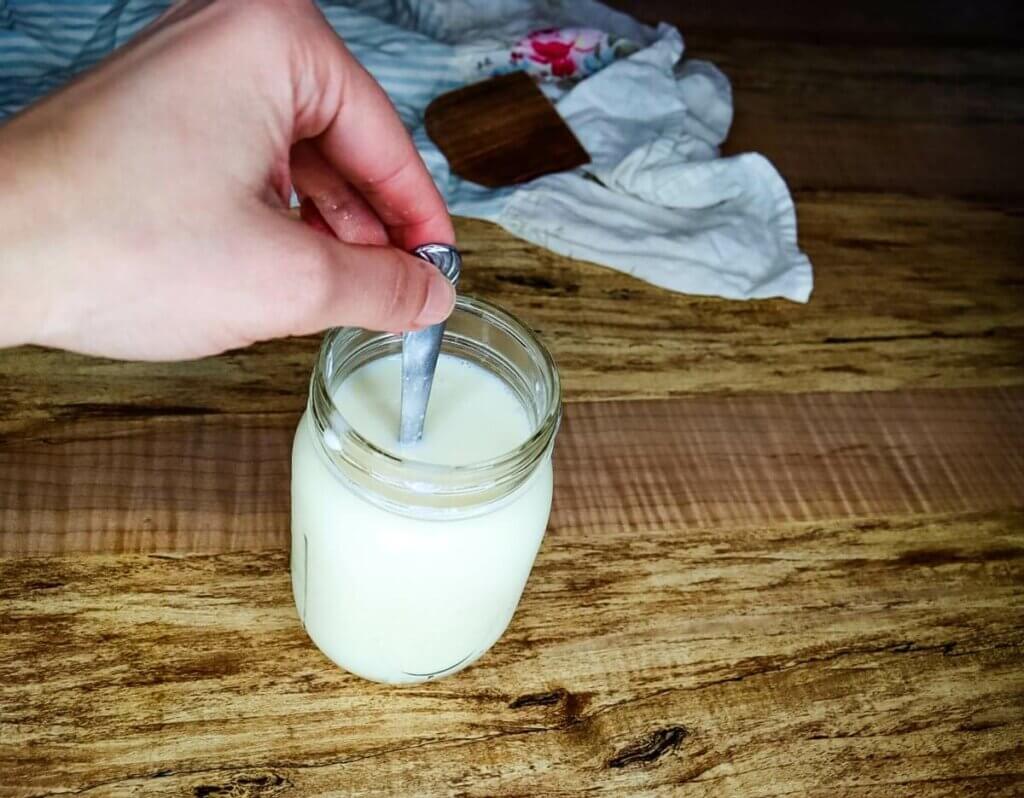
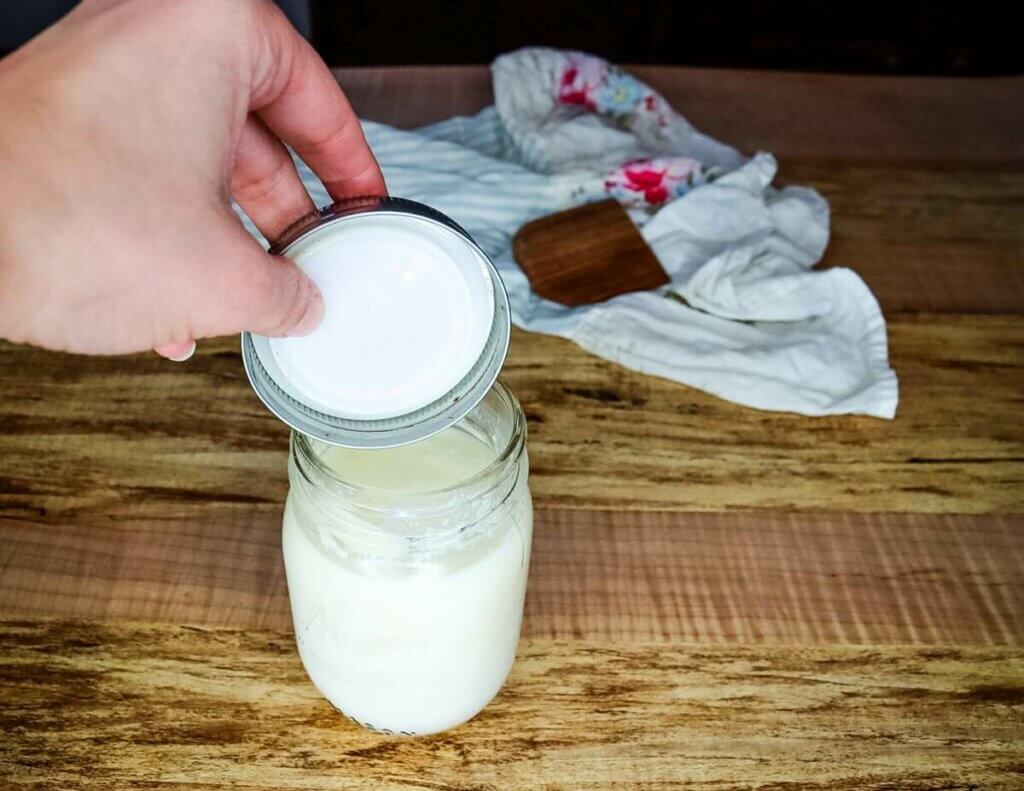
- Take just under two cups of milk and pour it into a clean pint-size jar.
- Add 2 tablespoons of cultured buttermilk (use 1 tbsp per cup of milk).
- Stir well to combine.
- Place a lid onto the jar and only screw it down one turn so it’s not air-tight, but enough to keep any bugs out.
- Leave at room temperature for 8-12 hours. You should begin to see bubbles on the sides of the jar and it will thicken up. If you like it tangier, leave it out until the desired taste is achieved.
- Transfer buttermilk to the refrigerator for 6 hours.
- It’s now ready to use!

How Long Does Buttermilk Last?
As I mentioned in my video, the great thing about buttermilk is that it preserves your milk so it will last much, much longer than fresh milk.
I typically use my buttermilk up in about two weeks, but it’s always just as fresh. The thing about buttermilk is that it will continue to get tangier the longer it sits. So it may be more tart than you prefer well before it truly goes “bad”.
If you prefer a nice mild flavor, I’d plan on making a fresh batch every two weeks to keep you in supply of this delicious product.
Tips and Tricks
When making cultured or fermented foods, you want to be sure to keep them about 6 feet away from other cultured or fermented foods. This is to avoid cross-contamination between cultures.
Because buttermilk is a mesophilic culture, I want to be careful to keep it away from things like my sourdough, kombucha, milk kefir, and yogurt. You can, however, keep multiple batches of buttermilk next to each other.
How to Use Buttermilk
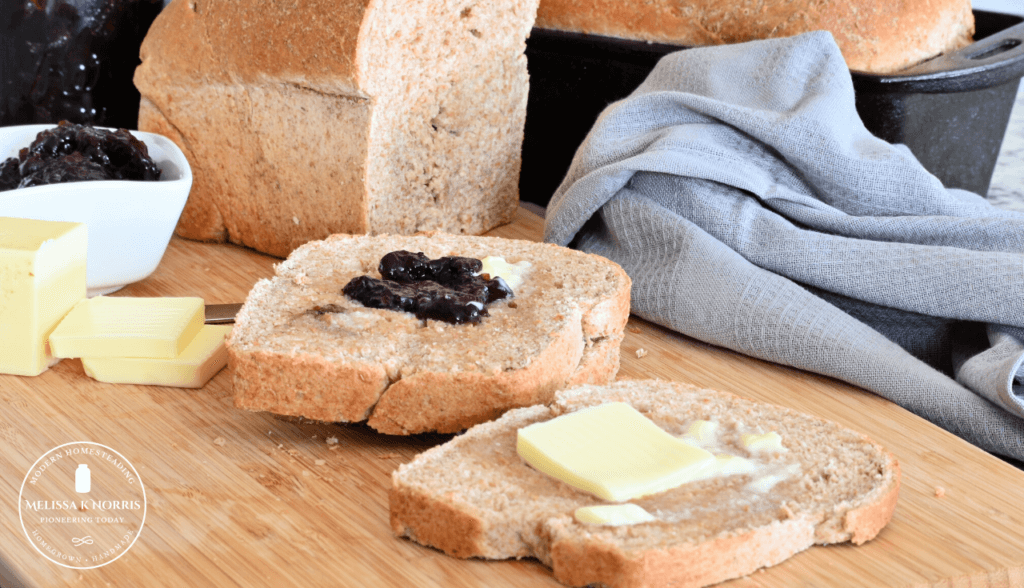
One of my favorite ways to use buttermilk is for my flaky buttermilk biscuits or my favorite honey whole wheat buttermilk sandwich bread. These two recipes call for having buttermilk on hand 365 days a year!
But I’m also excited that you can use buttermilk for cheese making, which is a course I’m creating for all the members of the Pioneering Today Academy. If you’re not yet a member, we’d love to have you come join us! Or, if enrollment isn’t currently open, you can sign up to get on the waitlist and we’ll email you when enrollment is open.
Some other recipes to use up your precious cultured buttermilk are these delicious buttermilk fried chicken strips, homemade buttermilk ranch dressing, diy pantry mixes, 1950’s vintage dinner rolls, or these peach buttermilk muffins! When buttermilk is involved, how can you go wrong?
Did you make this recipe? If so, I’d love for you to rate this recipe on the recipe card below. Also, I’d love to see how you’re using your buttermilk, so tag me on social media @melissaknorris.
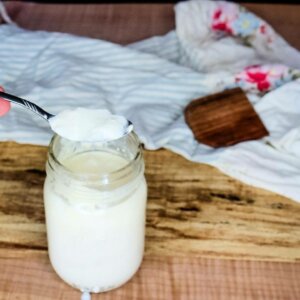
Cultured Buttermilk
Ingredients
- 2 cups milk raw, whole, etc.
- 2 tbsp buttermilk previously cultured, dehydrated cultures, or store-bought.
Instructions
- Pour just under 2 cups of milk into a clean pint-size mason jar.
- Add 2 tablespoons cultured buttermilk (be sure it says "live cultures" if it's store-bought) or read the instructions that came with your dehydrated cultures for the amount.
- Place lid lightly on jar, allowing it to breathe, set it a warm area of your home away from other cultures or ferments.
- Let sit for 8-12 hours.
- Once it's as thick as you'd like, move it to the refrigerator and let it sit for 6-8 more hours. Your buttermilk is now ready to drink or use in recipes!
Notes
- If using buttermilk from the store to culture your homemade buttermilk, be sure it says “live cultures” on the carton.
- Keep your buttermilk about 6 feet away from other ferments or cultures you might have going in your kitchen.
Nutrition
More Posts You May Enjoy:
- Scottish Highland Cows: A Unique Cattle Breed
- Ultimate Guide to Fermenting Vegetables
- Fermentation for Health Benefits & Food Preservation
- Fermented Pickles – Quick & Easy Old Fashioned Recipe
- Kahm Yeast (What, Why & Does it Ruin a Ferment)
- Fermented Dairy – Why You Should Be Doing This Now
- How to Make Homemade Yogurt That’s Thick and Creamy
- How to Make a Sourdough Starter + Tips for Success
- Rehydrating Sourdough Starter
- Best Beginner Sourdough Sandwich Bread No Yeast
- Sourdough Chocolate Bread From Scratch
- 8 Tips for Strengthening Your Immune System Now
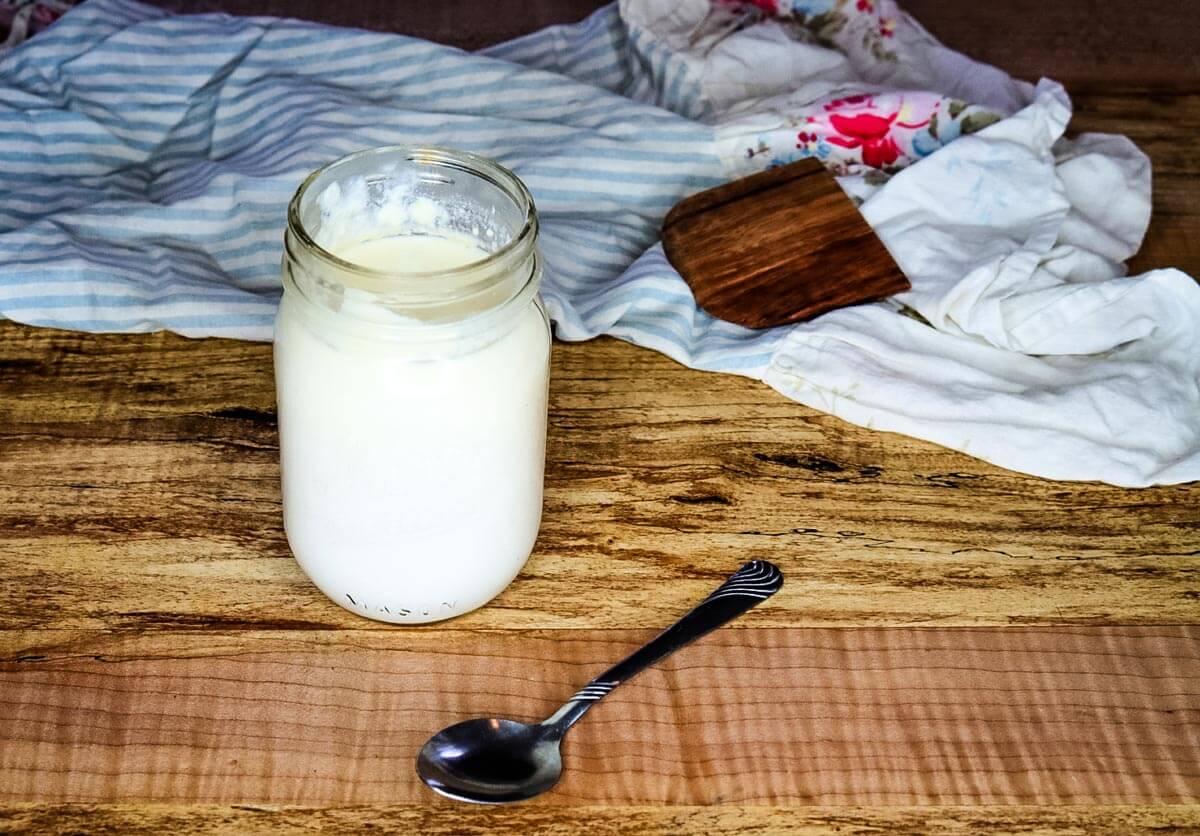
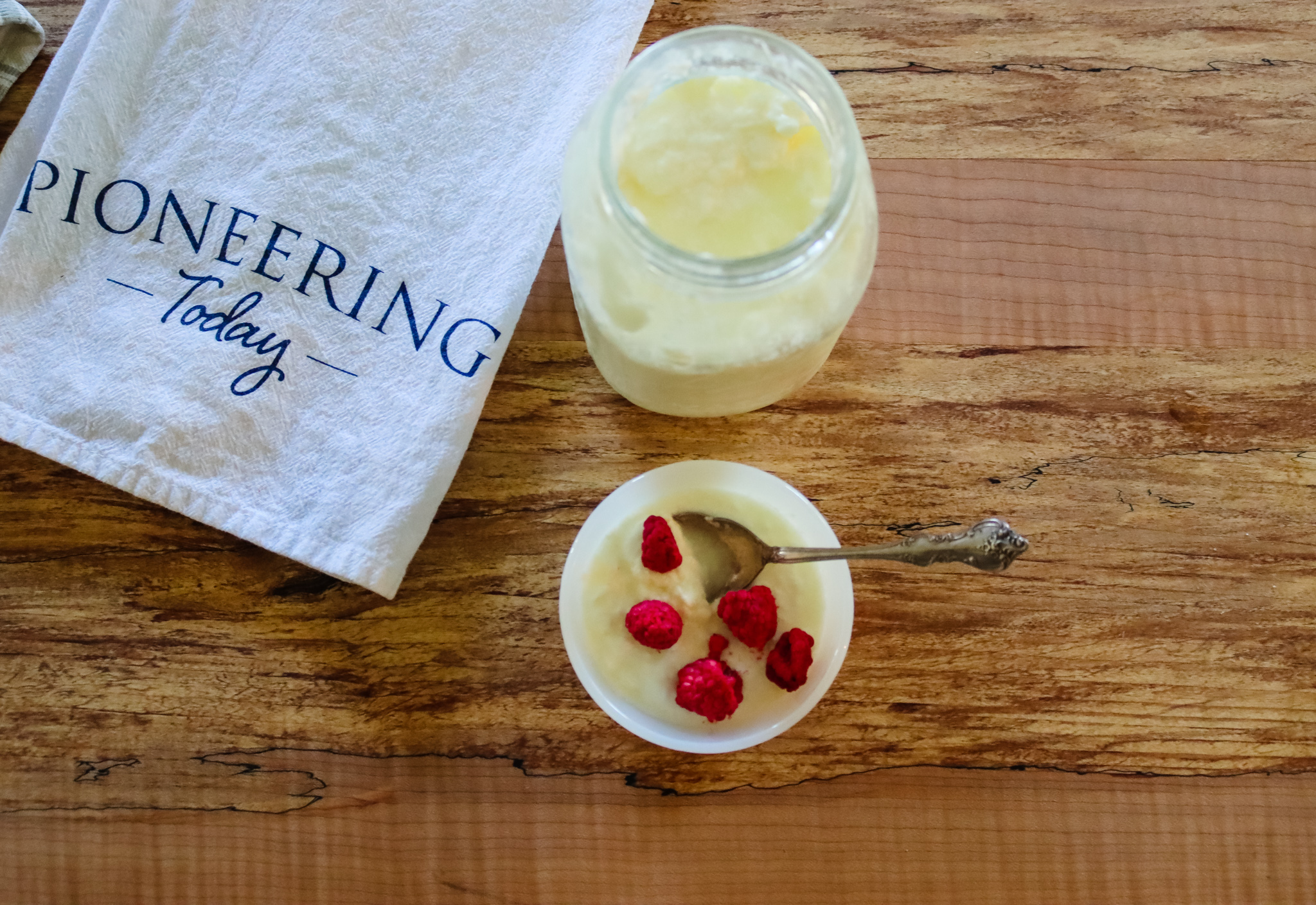
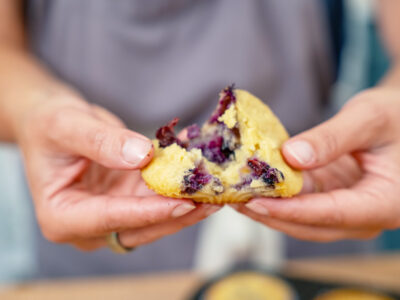
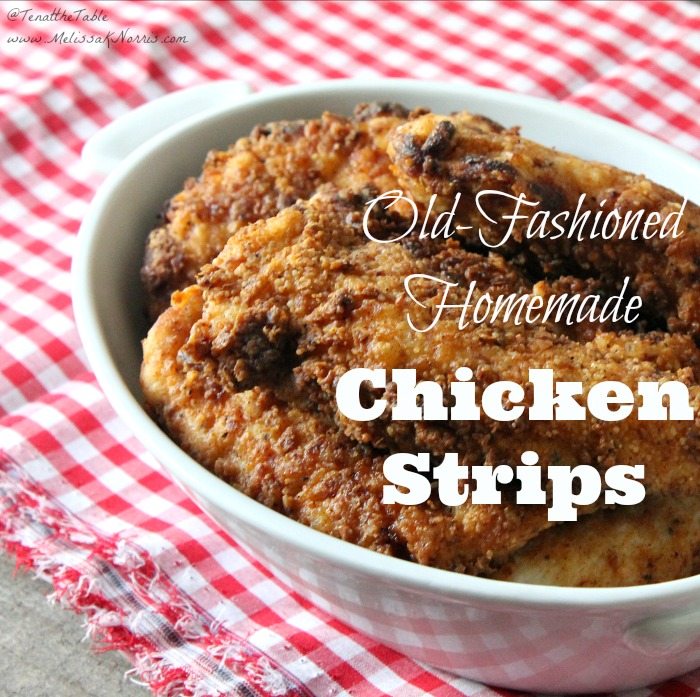
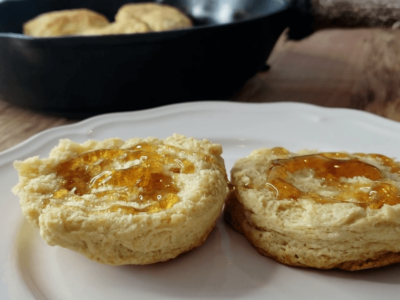
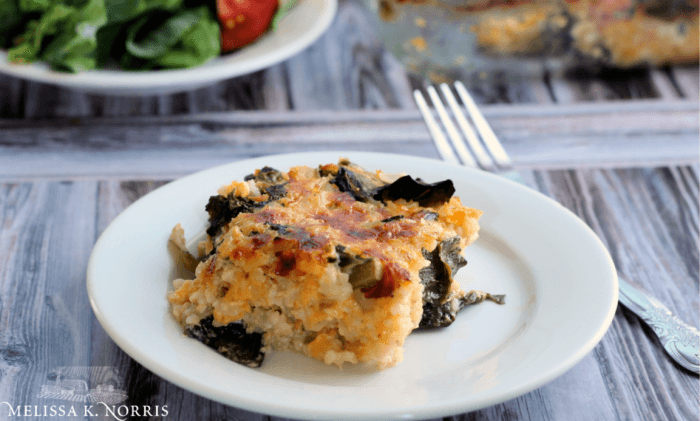
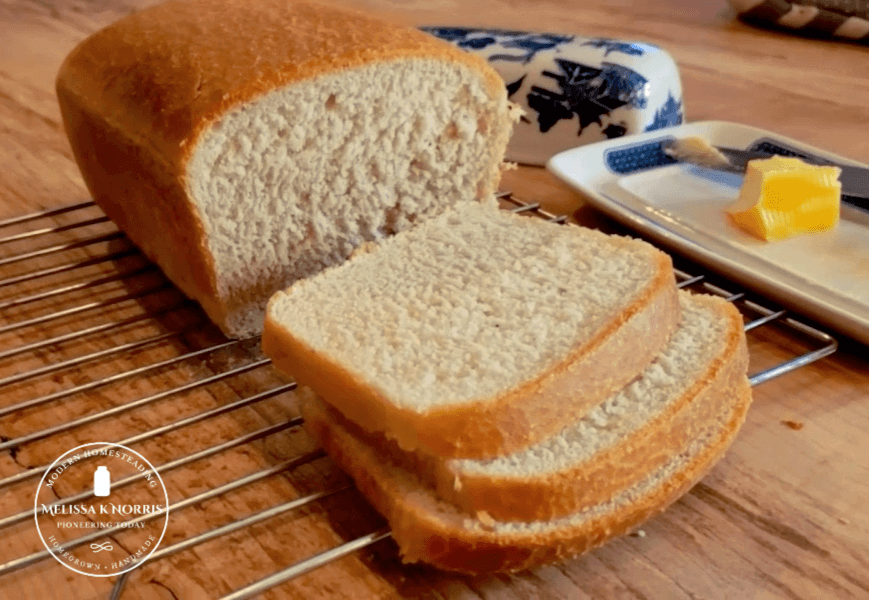
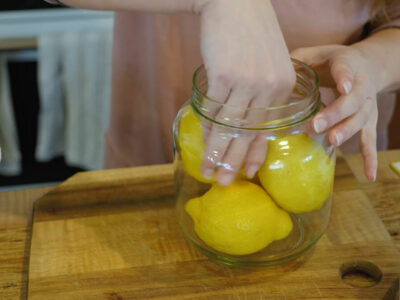
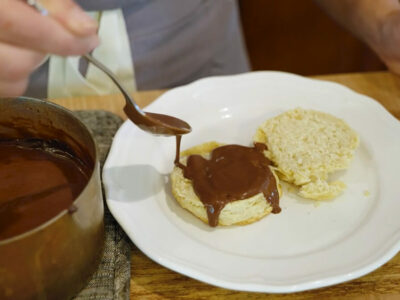
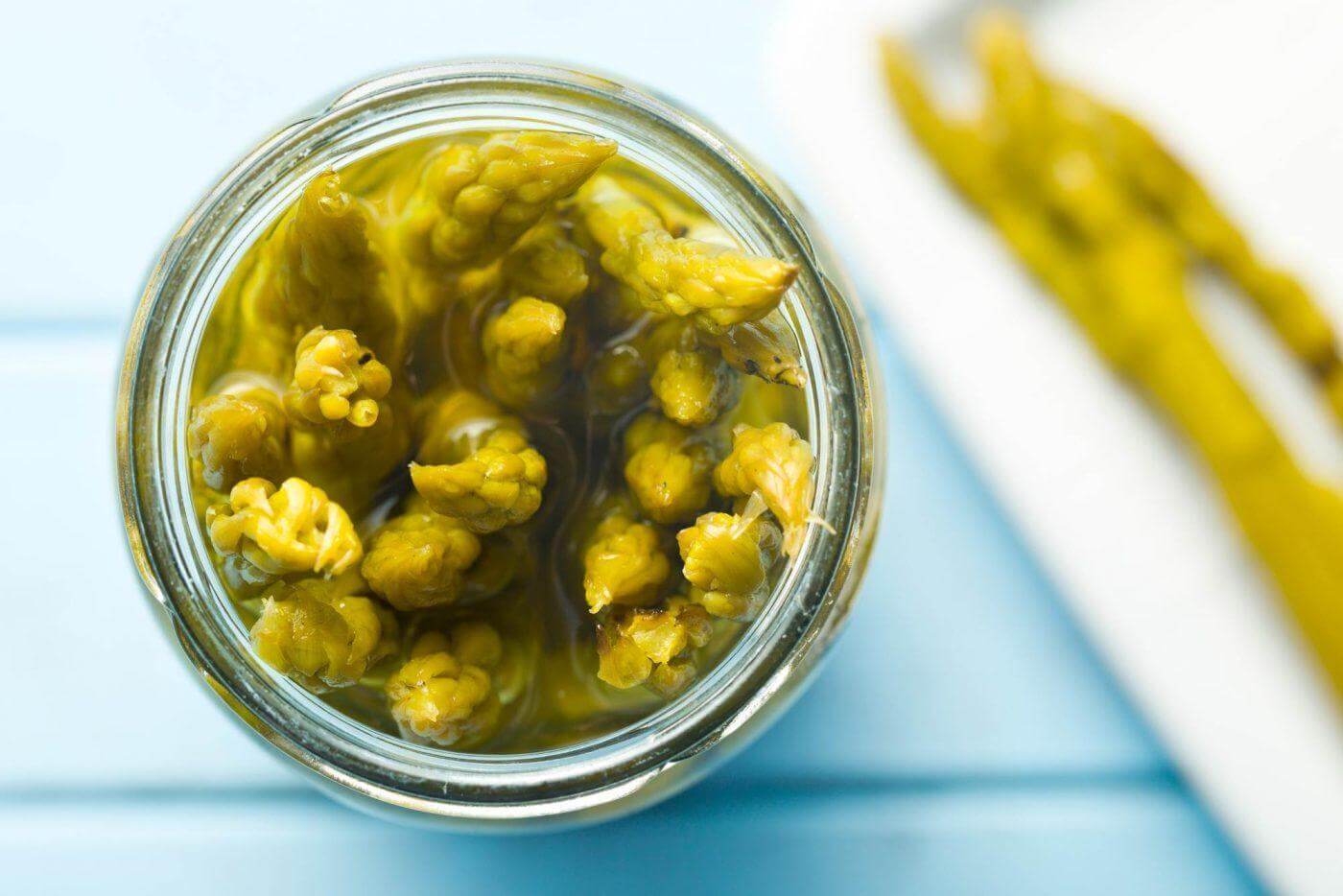

Hello Miss Melissa!
I just love all of your posts!! I use to follow you all the time, but got busy and dropped off. A friend and I just came across this video of you making the butter milk starter, but we can’t find the link for the dehydrated portion. Can you please let me know how to find that – when you have a min – I know you’ve got to be so busy!!
Thanks a bunch!
Heather in Texas
i thank you for the information
Thanks for this! I got some cultured buttermilk a few months ago and it seems to last forever. You’re so right that it does make better results than simply the lemon juice hack. So far I just keep it in the container it came in, but I may switch to glass jars so that I can clean them in between and start fresh.
I also do this with sour milk. I have a jar of sour milk in my fridge for biscuits and I just empty it and add a little more milk in and shake. And I have heavy cream that went funky too and it made the best drop biscuits ever (used it instead of butter)! I always check and make sure these milk products are sour (indicating fermentation) and not moldy (indicating the need to be thrown away).
I guess sometimes I’m afraid that I may actually be growing bad bacteria…but from all I’ve read, the mesophilic bacteria will die when baked. But does this also mean that you can’t get any bacterial benefits from the good bacteria? It seems difficult to find information on this online!
I gave this a try and had zero success. It didn’t bubble or thicken and I left it out for 19 hours! What did I do wrong? I used cultured buttermilk with live cultures and minimally pasteurized milk. Both bought from a local farmers market.
It sounds like the buttermilk with live cultures might not have had any live cultures left. I would suggest ordering a culture so you know it’s live.
Gotcha! I was trying to avoid that as the brand you suggested was out of stock and wasn’t sure what else I should go with. Do you have any suggestions on a different brand?
“Buttermilk actually helps extend the shelf-life of your baked goods because it contains natural emulsifiers.”
I’m fairly certain that increased shelf life of fermented foods is due to the acidity, which prevents certain mirobes from propogating in your food and thus spoiling it. Emulsions are just mixtures of things that wouldn’t otherwise mix but for the fact that one of the two items is dispersed in extremely small droplets.
this recipe is so simple and so refreshing ! We’ve been making a half-gallon every week — we drink it and use it in recipes. Absolutely the best! Thank you!
For years, I’ve bought buttermilk at the grocery and then pour it into quart glass jars when I get home. I found it lasts for months so I always have it on hand to make Southern cornbread. It tends to separate in the jar but a good shaking makes it cohesive before adding to recipe. I think I’ve kept it for as long as even a year or so and only once had to toss it. It’s amazing how much longer all food stays fresh if stored in glass vs plastic or cartons.
Silly question. But first, THANK YOU! This Green Acres city girl was shocked I can make my own buttermilk
My first batch went I to tue refrigerator, but I kept out 1/4 cup for my next batch. Where do I store this 1/4 cup? In the refrigerator? On my island at room temperature?
Hope I didn’t mess up! My 1/4 cup is currently in the refrigerator.
Thanks! I have been searching for a recipe for buttermilk, made the way my mom did. She always had buttermilk for baking and just having a glass full with cornbread. She made it this way, I can’t wait to make it!
I have been looking for a good corn bread recipe that cuts nice and doesn’t crumble. If you have one or anybody wants to share it with me, I will be very gratetul. Thanks
I was able to get started culture not prepackaged. No recipes came with it. How much do I need of the culture to start my buttermilk? I’m hoping to make 4 c. Buttermilk.
Thank you for this article, the time you spend to publish it, and the time you also spend to answer so many questions! I love making butter myself now- I never imagined it would be so easy! I used locally sourced heavy cream, and bought a pound of the same brand of butter for price comparison. My favorite part (besides the easy factor!) is that it was approximately 40% cheaper for me to make the butter myself- and the time spent is negligible, I am in the kitchen already, with other dirty dishes already, so what’s a few more minutes to whip up some butter! I feel like Ma Ingalls would be smilin’… and also in awe of the ease with which we can do so many modern homesteading tasks- electricity and food processors sure make a big difference! Thank you for sharing, Melissa. I’ll never worry about running out of butter again.
I buy raw milk. I made some butter but did not get all the cream out. The left over milk taste good. Don’t know why they call it buttermilk. I call it skim milk. Can you make buttermilk using the leftover milk with some cream left in? With no cream?
The word “HACK” has become so overused, that I cringe every time I hear it!!
Can I use live and active cultures from organic Greek yogurt to start buttermilk with whole milk? Just mix and not heat?
No, they’re two different cultures, one is thermophilic and one is mesophilic. Buttermilk requires mesophilic.
I have looked all around our area for buttermilk with live cultures. I have yet to find any. I even tried Azure & found none there that was labeled as such. I may have to break down & buy some dehydrated cultures to get started. Thanks for these instructions.
I made this with raw milk and cultured buttermilk I bought at the store. The first time it turned out great. I saved some for the starter. Started a second batch, just as before and it turned out great, but after a couple of days it has separated into 80 /20 whey/ buttermilk. The buttermilk part is very thick. Should I separate the whey out, stir it all back in…can I use the buttermilk as a starter?
Maybe this goes for buttermilk in the US but really this recipe is just homemade yogurt. Buttermilk is the leftover liquid you get when yogurt is churned to make butter. The concept being it still has all the good live culture without the fats- that mostly go into the butter.
Can you use powder buttermilk for a starter in the milk?
If it has live cultures yes but the package needs to indicate it has live cultures, if not, then no.
I was just wondering today if I could use my Grace Harbor Farms buttermilk to start some with raw milk that was still drinkable but past the pull date (so might get to off for drinking soon). And your instructions fit the bill?. FYI, I had buttermilk opened in May 2020 and used it up end of Dec. 2020. If it still smells okay and no mold it’s fine! Also I’ve had an unopened plain Greek yogurt (Greek Gods brand) a year past the pull date and it was still good. The good cultures in the plain yogurt and cultured buttermilk really keep the bad cultures away! I also found an unopened mascarpone in the back of the fridge that was still good as well and I’m actually a stickler for pull dates as I worked in grocery for 21 years!
Sorry, I forgot to add that the mascarpone was 5 yrs past the date and the plain yogurt was a qt. size, although I don’t know if the size mattered. Truly aged cheese ?.
Hi! can ultra-pasteurized milk be used? Thanks!
For cultured products, you should ultra-pasteurized.
Can you tell me to get started making the buttermilk for the first time….. which brand of cultures to buy ?
It’s all listed above in the article.
What makes it buttermilk….cultured milk on counter to what point. Taste the determining factor, consistency? I purchase raw milk and have cultured milk, but just to see how long it can be on counter and how tart. Ive seen some cultured milk videos, but i never found one where they answer at what point it is yogurt, what point buttermilk…..
Yogurt and buttermilk are two different cultures so it doesn’t go from one to the other. Yogurt is a different process as it requires heat (most yogurt cultures are thermophilic and require heat to ferment) whereas buttermilk is a mesophilic culture and doesn’t require heat. As for the buttermilk knowing it’s done it’s both consistency and flavor profile, time varies based on that as well as the temperature of your home because a warmer home will make it ferment faster than a colder home.
So if i put milk out on the counter and let it sit, at some point is it buttermilk? ..I mean how was the first buttermilk made? Just by being out? If this is how it was originally made, my question is, can i make the buttermilk culture myself. When do i know it is buttermilk? Slightly tart with yogurt-like consistency, but runnier. I guess that is what im asking….can i make the buttermilk culture myself?
If you have raw milk yes, if you’re using store-bought milk you have to add a culture otherwise it will just go bad. No, you can’t make it yourself unless you have raw fresh milk straight from the cow.
When you let fresh, raw milk* sit out at room temperature, UNcultured, you get “clabber,” which is also good. My mother loved clabber & we still make it, sometimes. So easy to make.
*It has its own natural good bacteria.
The buttermilk in our area says it contains “bacterial culture”. Do you know if that would work?
Yes that is what you’re after!
I’m so excited! I buy buttermilk all the time. Correct me if I’m wrong, I can use store-bought buttermilk (must say live cultures) and store-bought milk? It doesn’t need to be raw? Thank you!
You got it, it doesn’t have to be raw milk (my milk isn’t raw) and live cultures is the ticket!
very good
Hi Melissa!
I make my own butter from store bought organic heavy cream. I store this “buttermilk” for 10 days in the fridge and toss the unused portion. Can I make the cultured buttermilk from this buttermilk? Or would it be best to use whole milk? Thank you!
No, the culture for fermented buttermilk needs the fat/sugars found in the full milk, not the washed part.
I had the same question about using the buttermilk leftover from making butter. If you use Cultured Buttermilk for many of those recipes, what do you do with the buttermilk left over from making butter?
Buttermilk leftover from making butter can be used in baking recipes that call for water or as some of the milk, but if it calls for cultured buttermilk (because you have the fat content) then it’s best to use the cultured buttermilk for the best texture. I have bread recipes that use water so I would use the buttermilk from butter making in those.
I’m the only one in my home, so I’ve kept powdered buttermilk and powdered milk on hand. Are these ok?
The powdered buttermilk will only work if it says from live cultures and has been stored in a cool environment, otherwise, the cultures are probably dead. I haven’t tested it with powdered milk, it’s important that the milk source hasn’t been UHT pasteurized.
I ordered my stuff and can’t wait to make the biscuits
Yay, I’m so excited for you!
This is NOT real buttermilk, real buttermilk is a by product of making butter, it is what is leftover after the butter forms clumps. Cultured butter milk is a misnomer, because it is just skim milk that is cultured, making fermented sour skim milk.
You’re incorrect in saying it’s a misnomer (which I covered in the article), buttermilk is a by-product of making butter and cultured buttermilk is fermented milk (and it’s only skim milk if you use skim milk). Neither are a misnomer, hence the word CULTURED. They’re two different things.
Would it be possible to just use my kefir in the recipes you shared & get the same result? Is kefir as acidic as buttermilk?
hi! Can you make buttermilk with raw goat milk as well? Thank you, ?
so happy to see this – I currently always keep buttermilk on hand, but would like to be able to make smaller amounts – where can I buy buttermilk culture online? Thanks for all your helpful information.
After 2 weeks can I use 2Tbsp of my buttermilk to start another batch?
Yes, that’s what I did.
Once you put your buttermilk in the refrigerator, will that be problematic for sourdough starter also in the refrigerator? Will keeping them on different shelves be enough? We only have one fridge, and I’m super careful with my starter. Thanks for your advice!
Once in the fridge I haven’t had any crossing of cultures. Different shelves are adequate 🙂
I have all the same questions!
After the buttermilk has fermented is it safe to keep it in the fridge if you have sauerkraut in there?
Yes, it’s a cultured ferment so it will last in the fridge, the longer it’s in there the tangier it will get (and if left really long the possibility of mold, which you’ll see and then toss, I had that happen to one batch that I forgot about way in the back of the fridge). For more mild buttermilk do a new batch every 2 weeks.
I have a half gallon jug of buttermilk that I just keep fermenting in my refrigerator. When I use almost all of it in pancakes, I fill up the jug with fresh milk, let it sit on the counter for a day, and put it back in the fridge. If I only use a cup, I add another cup, shake it up and back in the fridge it goes. I have buttermilk all the time because I never let it run out. I probably bought the culture to start it originally over 10 years ago.
Thank you Melissa. I cant wait to give this a try! I have done the lemon juice adding for years. I did not know you could do this! Thanks for the info.
Can you freeze buttermilk?
Yes you can!
How long does this buttermilk keep?
I’m curious too!
It’s a cultured ferment so weeks, the longer it goes the tangier it gets. Most people prefer to do a new batch every 2 to 3 weeks due to this.